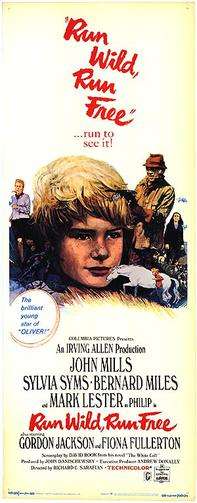Run Wild, Run Free
Run Wild, Run Free is a 1969 British drama film directed by Richard C. Sarafian and starring John Mills and Mark Lester. The film was written by David Rook, based on his novel The White Colt, and shot on location in Dartmoor, Devon, England.[3][4]
| Run Wild, Run Free | |
|---|---|
 Theatrical film poster | |
| Directed by | Richard C. Sarafian |
| Produced by | Andrew Donally John Danischewsky Monja Danischewsky |
| Screenplay by | David Rook |
| Based on | The White Colt 1967 novel by David Rook |
| Starring | John Mills Mark Lester |
| Music by | David Whitaker |
| Cinematography | Wilkie Cooper |
| Edited by | Geoffrey Foot |
Production company | Meadway |
| Distributed by | Columbia Pictures |
Release date |
|
Running time | 100 minutes |
| Country | United Kingdom |
| Language | English |
The film features a psychosomatically mute English boy (Lester), who sights a wild, white pony on the Dartmoor moors and sets out to tame him.[5] He is supported by an old moorman (Mills) and a neighboring farm girl, Fiona Fullerton. Much of the film is devoted to him searching for the pony and his family searching for him across the beautiful, foggy moors.[6][7]
Cast
| Actor | Role |
|---|---|
| John Mills | The Moorman (Colonel) |
| Mark Lester | Phillip Ransome |
| Gordon Jackson | Mr. Ransome |
| Fiona Fullerton | Diana |
| Sylvia Syms | Mrs. Ransome |
| Bernard Miles | Reg |
| Paul Griffiths | Young Phillip Ransome |
Reception
A. H. Weiler of The New York Times wrote: "If it is not a milestone in its genre, its cloying quotient is decidedly low. As a dissection of the rapport between two youngsters and a couple of wild animals in a largely uncomprehending world, it has enough honesty and genuine sentimentality to move mere grown-ups too."[8] Roger Ebert of the Chicago Sun-Times gave the film three stars out of four and called it "a sensitive and beautiful film, and probably ideal for kids from about the fourth grade up."[9] Gene Siskel of the Chicago Tribune also gave the film three stars out of four and wrote, "On the face of it, the film seems pat ... But the well-written script departs from tradition and gives us a story full of unpredictability and insight."[10] Kevin Thomas of the Los Angeles Times wrote: "Quite unabashedly, Run Wild, Run Free celebrates the power of love, yet it happily avoids the treacle – except for an overripe score – that characterizes most pictures about children and animals. It pulls out all stops emotionally but gets away with it because it has simplicity and intelligence."[11] The Monthly Film Bulletin wrote that "Richard Sarafian's combination of generally pedestrian images with a quivery, quavery wild-heart-of-Dartmoor sensitivity suggests some uncertainty as to whether the picture is aimed at the pony club set, or their more susceptible mothers and grandmothers."[12]
See also
References
- "'Run Wild, Run Free' Will Open at New Fox". Los Angeles Times. 23 May 1969. Part IV, p. 21.
- "Col's 'Run Wild' Preem Fit For a Princess". Variety. 28 May 1969. 2.
- "Run Wild, Run Free (1969)". BFI.
- "Reelstreets | Run Wild Run Free". www.reelstreets.com.
- Staff, Variety; Staff, Variety (1 January 1969). "Run Wild, Run Free".
- Ebert, Roger. "Run Wild, Run Free movie review (1969) | Roger Ebert". www.rogerebert.com. Retrieved 8 January 2020.
- Run Wild, Run Free (1969), retrieved 8 January 2020
- Weiler, A. H. (24 July 1969). "Rustic Simplicity Theme Of 'Run Wild, Run Free'". The New York Times. 25.
- Ebert, Roger (3 December 1969). "Run Wild, Run Free". RogerEbert.com Retrieved 2 January 2019.
- Siskel, Gene (1 December 1969). "Run Wild, Run Free". Chicago Tribune. Section 2, p. 20.
- Thomas, Kevin (28 May 1969). "'Run Wild, Free' on New Fox Screen". Los Angeles Times. Part IV, p. 11.
- "Run Wild, Run Free". The Monthly Film Bulletin. 36 (426): 149. July 1969.